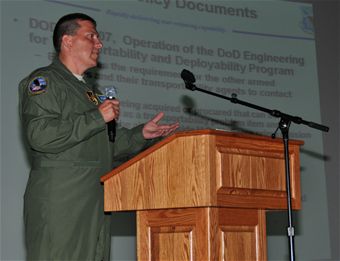 |
| News > Joint Base Charleston holds air transport conference |
 |
 |
| |
| Photos | |
 |
Master Sgt. Tom McPeak explains the process of transporting specialized cargo, Aug. 11, 2011 at Joint Base Charleston-Air Base, during an Air Transportation Test Loading Activity conference. More than 140 loadmasters, aerial porters and representative from various agencies who use airlift to transport cargo, traveled from all over the world to learn about the process of certifying specialized loads through ATTLA. McPeak is an ATTLA representative from Wright-Patterson Air Force Base, Ohio. (U.S. Air Force photo/Airman 1st Class Jared Trimarchi)
|
Download HiRes
|
|
|
|
Joint Base Charleston holds air transport conference
Posted 8/17/2011
 Email story
Print story
Email story
Print story

by Airman 1st Class Jared Trimarchi
Joint Base Charleston Public Affairs
8/17/2011 - JOINT BASE CHARLESTON, S.C. (AFNS) -- More than 140 people attended an Air Transportation Test Loading Activity conference Aug. 11 and 12 here.
ATTLA is the Department of Defense agency responsible for approving airlift cargo before it can be transported by aircraft.
Loadmasters, aerial porters and representatives from various agencies who use airlift to transport cargo traveled from around the world to learn about the process of certifying specialized loads through ATTLA.
"Before you can load specialized cargo such as a helicopter onto an aircraft, ATTLA must certify that the chopper is safe to transport," said Staff Sgt. Marcus Ohler, the 437th Airlift Wing aircrew training noncommissioned officer in charge. "This conference was held to explain how ATTLA certifies cargo, how to get your cargo certified and it gave people a chance to talk with ATTLA representatives."
The process of certifying cargo starts with testing a load's weight, height and dimensions. The numbers are then calculated to fit into three different airframes: a C-17 Globemaster III, a C-5 Galaxy, or a C-130 Hercules.
"If ATTLA determines that a piece of cargo is safe to transport, it issues a certification letter to the agency wanting to transfer that load," Ohler said. "That agency must then give the certification letter to the aerial ports who hand it to the loadmasters. No cargo is loaded onto an airframe without a certification letter."
Besides the weight and height of a load, a certification letter also gives the loadmaster an outline of how to safely secure the load.
"There are more than 5000 certification letters," Ohler said. "If one helicopter gets an extra antenna, the certification letter must be redone to accommodate that change. The new certification letter will explain how to compensate for the new antenna without damaging the equipment."
Master Sgt. George Northup, the 437th Airlift Wing aircrew training superintendent said, testing loads to ensure they are safe to fly is a meticulous procedure.
"Safety is a top priority when it comes to loading thousands of pounds onto an aircraft," he said. "ATTLA tests everything from the best place to tie down a load to the maximum limit of a fire truck's suspension.
"If you load a fire truck or a pickup truck onto an airframe, the vehicle's suspension is put under heavy forces. If the force is too much for the suspension to hold, a tire might pop and the vehicle could become loose. The certification process prevents mishaps like that from happening."
Everyday, fire trucks, helicopters and life-saving equipment are transported to the war fighter via airlift.
"Knowing how the ATTLA process works and how to get cargo certified makes transporting loads faster," Ohler said. "Transporting cargo safely to ground troops when they need it ultimately saves lives. We are trying to avoid delays from not having a certification letter."
Overall the conference was a great success, Ohler said.
"We had more than half of the participants ask questions about the ATTLA process," he said. "Even after the conference, a long line formed for one-on-one interviews with ATTLA representatives.
"The people who attended can take the knowledge from the conference back to their home bases," Ohler said. "I heard nothing but great feedback from the conference and everybody seemed to get something out of it."
|
|
|
|
|
|
 |
|



